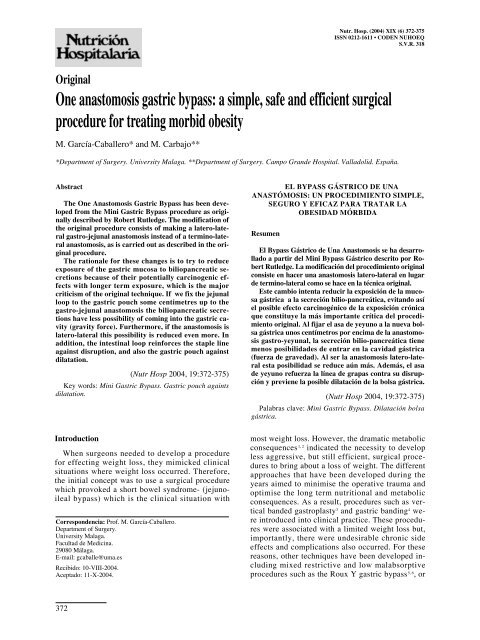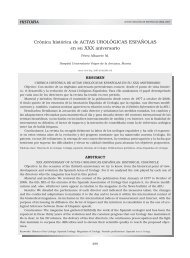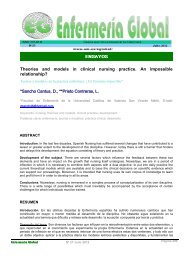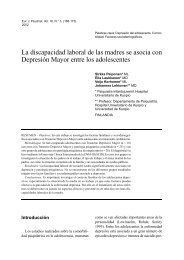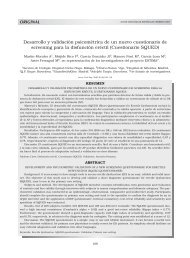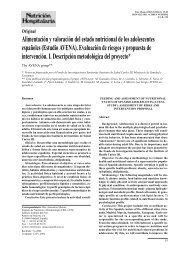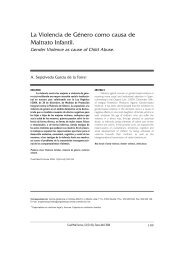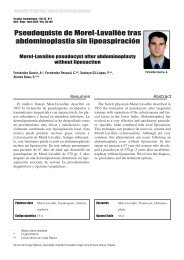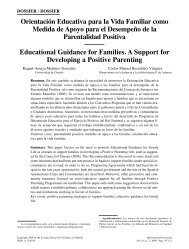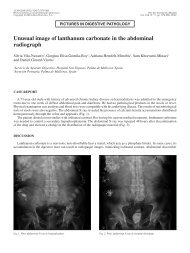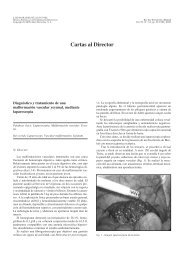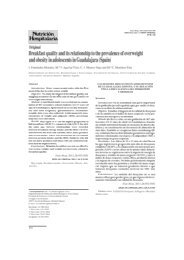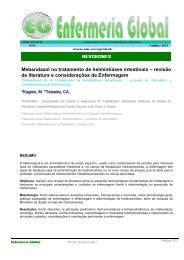One anastomosis gastric bypass: a simple, safe and ... - SciELO
One anastomosis gastric bypass: a simple, safe and ... - SciELO
One anastomosis gastric bypass: a simple, safe and ... - SciELO
You also want an ePaper? Increase the reach of your titles
YUMPU automatically turns print PDFs into web optimized ePapers that Google loves.
Original<br />
<strong>One</strong> <strong>anastomosis</strong> <strong>gastric</strong> <strong>bypass</strong>: a <strong>simple</strong>, <strong>safe</strong> <strong>and</strong> efficient surgical<br />
procedure for treating morbid obesity<br />
M. García-Caballero* <strong>and</strong> M. Carbajo**<br />
*Department of Surgery. University Malaga. **Department of Surgery. Campo Gr<strong>and</strong>e Hospital. Valladolid. España.<br />
Abstract<br />
The <strong>One</strong> Anastomosis Gastric Bypass has been developed<br />
from the Mini Gastric Bypass procedure as originally<br />
described by Robert Rutledge. The modification of<br />
the original procedure consists of making a latero-lateral<br />
gastro-jejunal <strong>anastomosis</strong> instead of a termino-lateral<br />
<strong>anastomosis</strong>, as is carried out as described in the original<br />
procedure.<br />
The rationale for these changes is to try to reduce<br />
exposure of the <strong>gastric</strong> mucosa to biliopancreatic secretions<br />
because of their potentially carcinogenic effects<br />
with longer term exposure, which is the major<br />
criticism of the original technique. If we fix the jejunal<br />
loop to the <strong>gastric</strong> pouch some centimetres up to the<br />
gastro-jejunal <strong>anastomosis</strong> the biliopancreatic secretions<br />
have less possibility of coming into the <strong>gastric</strong> cavity<br />
(gravity force). Furthermore, if the <strong>anastomosis</strong> is<br />
latero-lateral this possibility is reduced even more. In<br />
addition, the intestinal loop reinforces the staple line<br />
against disruption, <strong>and</strong> also the <strong>gastric</strong> pouch against<br />
dilatation.<br />
Introduction<br />
When surgeons needed to develop a procedure<br />
for effecting weight loss, they mimicked clinical<br />
situations where weight loss occurred. Therefore,<br />
the initial concept was to use a surgical procedure<br />
which provoked a short bowel syndrome- (jejunoileal<br />
<strong>bypass</strong>) which is the clinical situation with<br />
372<br />
(Nutr Hosp 2004, 19:372-375)<br />
Key words: Mini Gastric Bypass. Gastric pouch againts<br />
dilatation.<br />
Correspondencia: Prof. M. García-Caballero.<br />
Department of Surgery.<br />
University Malaga.<br />
Facultad de Medicina.<br />
29080 Málaga.<br />
E-mail: gcaballe@uma.es<br />
Recibido: 10-VIII-2004.<br />
Aceptado: 11-X-2004.<br />
Nutr. Hosp. (2004) XIX (6) 372-375<br />
ISSN 0212-1611 • CODEN NUHOEQ<br />
S.V.R. 318<br />
EL BYPASS GÁSTRICO DE UNA<br />
ANASTÓMOSIS: UN PROCEDIMIENTO SIMPLE,<br />
SEGURO Y EFICAZ PARA TRATAR LA<br />
OBESIDAD MÓRBIDA<br />
Resumen<br />
El Bypass Gástrico de Una Anastomosis se ha desarrollado<br />
a partir del Mini Bypass Gástrico descrito por Robert<br />
Rutledge. La modificación del procedimiento original<br />
consiste en hacer una <strong>anastomosis</strong> latero-lateral en lugar<br />
de termino-lateral como se hace en la técnica original.<br />
Este cambio intenta reducir la exposición de la mucosa<br />
gástrica a la secreción bilio-pancreática, evit<strong>and</strong>o así<br />
el posible efecto carcinogénico de la exposición crónica<br />
que constituye la más importante crítica del procedimiento<br />
original. Al fijar el asa de yeyuno a la nueva bolsa<br />
gástrica unos centímetros por encima de la <strong>anastomosis</strong><br />
gastro-yeyunal, la secreción bilio-pancreática tiene<br />
menos posibilidades de entrar en la cavidad gástrica<br />
(fuerza de gravedad). Al ser la <strong>anastomosis</strong> latero-lateral<br />
esta posibilidad se reduce aún más. Además, el asa<br />
de yeyuno refuerza la línea de grapas contra su disrupción<br />
y previene la posible dilatación de la bolsa gástrica.<br />
(Nutr Hosp 2004, 19:372-375)<br />
Palabras clave: Mini Gastric Bypass. Dilatación bolsa<br />
gástrica.<br />
most weight loss. However, the dramatic metabolic<br />
consequences 1, 2 indicated the necessity to develop<br />
less aggressive, but still efficient, surgical procedures<br />
to bring about a loss of weight. The different<br />
approaches that have been developed during the<br />
years aimed to minimise the operative trauma <strong>and</strong><br />
optimise the long term nutritional <strong>and</strong> metabolic<br />
consequences. As a result, procedures such as vertical<br />
b<strong>and</strong>ed gastroplasty 3 <strong>and</strong> <strong>gastric</strong> b<strong>and</strong>ing 4 were<br />
introduced into clinical practice. These procedures<br />
were associated with a limited weight loss but,<br />
importantly, there were undesirable chronic side<br />
effects <strong>and</strong> complications also occurred. For these<br />
reasons, other techniques have been developed including<br />
mixed restrictive <strong>and</strong> low malabsorptive<br />
procedures such as the Roux Y <strong>gastric</strong> <strong>bypass</strong> 5, 6 , or
high malabsorptive as biliopancreatic <strong>bypass</strong> 7, 8 <strong>and</strong><br />
duodenal switch operations 9, 10 . However, these are<br />
also associated with more morbidity <strong>and</strong> significant<br />
chronic nutritional <strong>and</strong> metabolic complications.<br />
In 1997 Robert Rutledge took again as a starting<br />
point the Billroth II <strong>gastric</strong> operation which has been<br />
carried out previously by others 11 <strong>and</strong> shown in a million<br />
patients to provoke loss of weight. He adapted<br />
the original operation as described by Billroth <strong>and</strong> applied<br />
laparoscopic techniques to its further development.<br />
Indeed, excellent results for the first 1,274 patients<br />
who were treated using this technique have been<br />
reported 12 .<br />
Some surgeons were concerned that patients who<br />
were subjected to a Billorth II procedure (as well as<br />
those undergoing other procedures for peptic ulcer disease<br />
such as vagotomy) had a risk of 0.8% of developing<br />
<strong>gastric</strong> cancer within 25 years of the operation<br />
<strong>and</strong> have criticized the procedure 13 . However, this finding<br />
has not been consistent <strong>and</strong> others have failed to<br />
demonstrate this link 14 .<br />
We have studied in depth the advantages <strong>and</strong> disadvantages<br />
of the Mini Gastric Bypass procedure,<br />
<strong>and</strong> finally we have concluded that the new procedure<br />
had many differences when compared with the<br />
original Billroth II, or other <strong>gastric</strong> <strong>bypass</strong>es based<br />
on it. Furthermore, these differences could explain<br />
the results reported by Rutledge. The new procedure<br />
has, in our opinion, clear advantages over other surgical<br />
operations in use at present for treating morbid<br />
obesity.<br />
However, in order to reduce the contact of biliopancreatic<br />
secretions with the <strong>gastric</strong> mucosa, <strong>and</strong> also<br />
for reducing the possibility of <strong>gastric</strong> pouch dilatation,<br />
we have introduced some modifications into the<br />
Mini Gastric Bypass as originally described by Robert<br />
Rutledge. These will be described below.<br />
The technique<br />
Mini Gastric Bypass <strong>One</strong> Anastomosis Gastric Bypass<br />
Fig. 1. —Schematic representation of the original Mini Gastric<br />
Bypass <strong>and</strong> the <strong>One</strong> Anastomosis Gastric Bypass.<br />
<strong>One</strong> <strong>anastomosis</strong> <strong>gastric</strong> <strong>bypass</strong>: a<br />
<strong>simple</strong>, <strong>safe</strong> <strong>and</strong> efficient surgical<br />
procedure for treating morbid obesity<br />
The laparoscopic <strong>One</strong> Anastomosis Gastric Bypass<br />
is similar to the Mini Gastric Bypass 12 . The differences<br />
are illustrated in figure 1. As can be observed, the<br />
gastro-jejunal <strong>anastomosis</strong> is performed latero-laterally<br />
instead of termino-laterally.<br />
Detailed description of the surgical tecnique<br />
The procedure commences by inducing a pneumoperitoneum<br />
through the left subcostal space (figure<br />
2).<br />
The first trocar (10 mm) is introduced through the<br />
middle point of the line between the xiphoid <strong>and</strong> umbilicus,<br />
<strong>and</strong> through which we introduce the camera.<br />
The second trocar (12 mm) is positioned 5 cm to the<br />
right side of the first, <strong>and</strong> at the same level. Then, the<br />
third trocar (12 mm) is inserted 5 cm to the left side<br />
of the first one, <strong>and</strong> again at the same level. The<br />
fourth <strong>and</strong> smallest trocar (5 mm) is inserted into the<br />
right flank at the lower edge of the liver (internal<br />
view control) <strong>and</strong> serves to allow the introduction of<br />
the liver retractor. Finally, the fifth trocar (5 mm) is<br />
positioned in a left sub-costal position, <strong>and</strong> is approximately<br />
10 cm away from the second trocar (see diagram).<br />
Once the operation field has been prepared, the<br />
esophago-<strong>gastric</strong> junction is identified. The first step<br />
consists of preparing a hole in the <strong>gastric</strong> fundus at the<br />
esophago-<strong>gastric</strong> junction. This allows the access to<br />
the posterior wall of the stomach which will facilitate<br />
the later creation of the <strong>gastric</strong> pouch.<br />
Then, we move to the lesser curvature <strong>and</strong> identify<br />
a point at the “crow’s foot” level. As close as<br />
possible to the <strong>gastric</strong> serosa, we start to make a hole<br />
in order to gain access to the posterior wall of the<br />
stomach. Once we come to the posterior stomach<br />
wall we introduce a 45 mm EndoGhia, 3.5 mm cartridge<br />
(Tyco ® ) <strong>and</strong> transect the stomach horizontally.<br />
Then, we commence the vertical stomach transection<br />
which progresses until the<br />
esophageal-<strong>gastric</strong> junction has been reached, using<br />
a 1 cm naso<strong>gastric</strong> tube placed in the lesser curvature<br />
of the stomach, as a guide. We use two or three<br />
60 mm EndoGhia, 3.5 mm cartridges (Tyco ® ) to<br />
complete the transaction of the stomach. An additional<br />
30 or 45 mm EndoGhia, 3.5 mm cartridge<br />
(Tyco ® ), is sometimes needed.<br />
After making the <strong>gastric</strong> pouch, we insert a sixth<br />
trocar (5 mm) at McBurney’s point. We proceed identifying<br />
the angle of Treitz. Then we measure aproximately<br />
2 m jejunum distally from this point. Once this<br />
point has been localized, a 10 cm long <strong>and</strong> 0.5 cm wide<br />
rubber b<strong>and</strong> is passed around the small intestine.<br />
With the help of a “grasp”, we approximate the jejunal<br />
loop to the <strong>gastric</strong> pouch.<br />
When both are in position side by side, we fix the<br />
jejunum to the staple line of the <strong>gastric</strong> pouch with 6<br />
to 10 sutures using an Endostitch (Tyco ® ). When<br />
both are fixed, we anastomose the <strong>gastric</strong> pouch to<br />
Nutr. Hosp. (2004) 19 (6) 372-375<br />
373
the jejunal loop using a 30 mm EndoGhia, 3.5 mm<br />
cartridge (Tyco ® ) from which we introduce only a<br />
part (the length of the <strong>anastomosis</strong> is between 15 <strong>and</strong><br />
20 mm). The <strong>gastric</strong> <strong>and</strong> jejunal holes are closed<br />
using 4 to 6 sutures. For checking if the <strong>anastomosis</strong><br />
is securely closed, we put it under saline <strong>and</strong> inject<br />
60 to 100 ml of air through the naso<strong>gastric</strong> tube <strong>and</strong><br />
there should be no air bubbles seen to be escaping<br />
from the <strong>anastomosis</strong>. Finally we seal the <strong>anastomosis</strong><br />
by using 2 ml of fibrin glue (Tissucol ® ). We place<br />
a suture between the intestinal loop <strong>and</strong> the <strong>gastric</strong><br />
antrum so as to “unload” the <strong>anastomosis</strong> trying to<br />
avoid any tension on it. An omentoplasty is always<br />
performed using omentum to cover the gastro-jejunal<br />
<strong>anastomosis</strong>. Finally, a soft drain is always positioned<br />
below the liver.<br />
Twenty four hours after the operation we perform a<br />
radiological contrast study (oral gastrograffin) to<br />
check that the pouch <strong>and</strong> <strong>anastomosis</strong> is not leaking. If<br />
the result is normal we start as a three hours liquids tolerance<br />
checking before the patient goes home.<br />
Comments<br />
The surgery to treat morbid obesity should follow,<br />
in our opinion, the principle of “the <strong>simple</strong>st procedure<br />
that permits enough weight loss with less short <strong>and</strong><br />
long-term complications <strong>and</strong> better quality of life”.<br />
The <strong>One</strong> Anastomosis Gastric Bypass is a minimally<br />
traumatic procedure for the patient. The techni-<br />
Fig. 2.—Schema of the port<br />
sites <strong>and</strong> the instruments<br />
used through each of them.<br />
que is carried out in the same way always, <strong>and</strong> independently<br />
of the weight of the patient. However, the<br />
results are always comparable: the patients lose<br />
around 80% of their pre-operative excess body weight<br />
during the next two years (most of this occurs during<br />
the first year). This has been shown from the results of<br />
the first 200 first patients we have operated on.<br />
The most important changes that occurs in this operation<br />
when compared with the classical Roux-en-Y<br />
Gastric Bypass (RYGB) are: 1) it is not necessary to<br />
interrupt the physiological intestinal transit; 2) hence,<br />
we do not produce a hole in the mesentery which<br />
avoid the possibility of developing around 8% postoperative<br />
intestinal obstruction 12 ; 3) the latero-lateral<br />
gastrojejunal <strong>anastomosis</strong> using linear staples also<br />
avoids the 10% risk of gastrojejunal strictures occurring<br />
after RYGB; 4) finally, we also avoid the luminal<br />
nutrients having contact with the intestinal jejunal<br />
mucosa without prior mixture with the biliopancreatic<br />
secretion. This would not happen under physiological<br />
conditions (luminal nutrients are always together with<br />
biliopancreatic secretion as happens in our <strong>bypass</strong><br />
procedure) which has been proven to provoke mucosal<br />
hypotrophy <strong>and</strong> bacterial translocation 13 .<br />
The most important change when compared with the<br />
original Mini Gastric Bypass as described by Robert<br />
Rutledge 14 , is the type of <strong>anastomosis</strong>. Our modification<br />
of the original procedure tries to minimise the contact<br />
<strong>and</strong> chronic effect of the biliopancreatic secretions on<br />
<strong>gastric</strong> mucosa, which is an important reason for per-<br />
374 Nutr. Hosp. (2004) 19 (6) 372-375<br />
M. García-Caballero y M. Carbajo
forming this otherwise very efficient procedure. At the<br />
same time, we cover the distal part of the staple line <strong>and</strong><br />
protect it against disruption <strong>and</strong> dilatation.<br />
To achieve that, we fix the jejunal loop to the stomach<br />
pouch some centimetres over the <strong>anastomosis</strong> (see figure<br />
1) so that the biliopancreatic secretion fall down some<br />
centimetres to the 15 to 20 mm latero-lateral gastro-jejunal<br />
<strong>anastomosis</strong>. The effect of the gravity force <strong>and</strong> the<br />
lateral connection with the stomach (together with the<br />
entry of <strong>gastric</strong> secretion <strong>and</strong> the alimentary bolus), minimizes<br />
the contact of the biliopancreatic secretions with<br />
the <strong>gastric</strong> mucosa (as demonstrated during the clinical<br />
evolution in our first 200 patients where there hasn’t been<br />
symptomatic episodes of <strong>gastric</strong> irritation).<br />
In summary, the <strong>One</strong> Anastomosis Gastric Bypass is,<br />
as is also the original Mini Gastric Bypass, a quick to<br />
perform <strong>and</strong> low risk procedure with minimal postoperative<br />
complications experienced by the patients.<br />
Because of the minimum trauma associated with this<br />
procedure, the postoperative recovery period is in the<br />
region of 24 hours. The patients recover quickly <strong>and</strong><br />
can resume their activities within two to three days. The<br />
weight loss that occurs subsequently, is not accompanied<br />
by nutritional or metabolic disturbances. This<br />
weight loss is maintained for more than two years (as<br />
demonstrated by the long-term follow-up of Mini Gastric<br />
Bypass patients) since the size of the <strong>gastric</strong> pouch<br />
<strong>and</strong> the site of intestinal <strong>anastomosis</strong> with the intestine<br />
(aproximately 2 m from the angle of Treitz) is the same<br />
as in this procedure. The only change compared with<br />
Mini Gastric Bypass, the latero-lateral gastro-jejunal<br />
<strong>anastomosis</strong>, <strong>and</strong> results in conditions that disminis the<br />
contact <strong>and</strong> hence the chronic effect of biliopancreatic<br />
secretions on the <strong>gastric</strong> mucosa. Also, by using fibrin<br />
glue sealant on the one <strong>and</strong> only <strong>anastomosis</strong> that is<br />
performed, the risk of anastomotic leakage or fistula<br />
formation is reduced as low as possible.<br />
<strong>One</strong> <strong>anastomosis</strong> <strong>gastric</strong> <strong>bypass</strong>: a<br />
<strong>simple</strong>, <strong>safe</strong> <strong>and</strong> efficient surgical<br />
procedure for treating morbid obesity<br />
References<br />
1. Deitel M: Jejuno-colic <strong>and</strong> jejuno-iloeal <strong>bypass</strong>: an historical<br />
perspective. In: Surgery for the Morbidly Obese Patient. M.<br />
Deitel, editor. Philadelphia. Lea & Febiger 1989, pp. 81-90.<br />
2. Deitel M, Shahi B, An<strong>and</strong> PK, Deitel FH, Cardinell DL: Longterm<br />
outcome in a series of jejuno-ileal <strong>bypass</strong> patients. Obes<br />
Surg 1993; 3:247-<br />
3. Mason EE: Vertical b<strong>and</strong>ed gastroplasty for morbid obesity.<br />
Arch Surg 1982, 117:701-6.<br />
4. Belachew M, Legr<strong>and</strong> M, Jacquet N: Laparoscopic adjustable<br />
silicone <strong>gastric</strong> b<strong>and</strong>ing in the treatment of morbid obesity: a<br />
preliminary report. Surg Endosc 1994, 8:1354-6.<br />
5. Torres JC, Oca CF, Garrison RN: Gastric <strong>bypass</strong> Roux-en-Y<br />
gastro-jejunostomy from the lesser curvature. South Med J<br />
1983, 76:1217-21.<br />
6. De la Torre RA, Scott JS: Laparoscopic Roux-en-Y <strong>gastric</strong> <strong>bypass</strong>:<br />
a totally intra-abdominal approach —technique <strong>and</strong> preliminary<br />
report. Obes Surg 1999, 9:492-8.<br />
7. Scopinaro N, Gianetta E, Civalleri D, Bonalumi U, Bachi V:<br />
Bilio-pancreatic <strong>bypass</strong> for obesity: II. Initial experience in<br />
man. Br J Surg 1979, 66:618-20.<br />
8. Paiva D, Bernardes L, Suretti L: Laparoscopic diversion for<br />
the treatment of morbid obesity: initial experience. Obes Surg<br />
2000, 11:619-22.<br />
9. Hess DS, Hess DW: Biliopancreatic diversion with a duodenal<br />
switch. Obes Surg 1998, 8:267-82.<br />
10. Feng JJ, Gagner M: Laparoscopic biliopancreatic diversion<br />
with duodenal switch. Semin Laparosc Surg 2002, 9:125-9.<br />
11. Mason EE, Ito C: Gastric <strong>bypass</strong> in obesity. Surg Clin North<br />
Am 1967, 47:1345-51.<br />
12. Papasavas PK, Caushaj PF, McCormick JT, Quinlin RF, Hayetian<br />
FD, Maurer J, Kelly JJ, Gagne DJ: Laparoscopic management<br />
of complications following laparoscopic Roux-en-Y<br />
<strong>gastric</strong> <strong>bypass</strong> for morbid obesity. Surg Endosc 2003, 17:610-<br />
4.<br />
13. García-Caballero M: Adaptación intestinal: Factores tróficos y<br />
mecanismos celulares. Cir Esp 1995, 58:52-60.<br />
14. Rutledge R: The mini-<strong>gastric</strong> <strong>bypass</strong>: experience with the first<br />
1,274 cases. Obes Surg 2001, 11:276-80.<br />
15. Bekavac-Beslin M, Halkic N: Gastric stump cancer after stomach<br />
resection due to peptic disease. Chir Ital 1996, 48:9-12.<br />
16. Bassily R, Smallwood RA, Crotty B. Risk of <strong>gastric</strong> cancer is<br />
not increased after partial gastrectomy. J Gastroenterol Hepatol<br />
2000, 15:762-5.<br />
Nutr. Hosp. (2004) 19 (6) 372-375<br />
375


